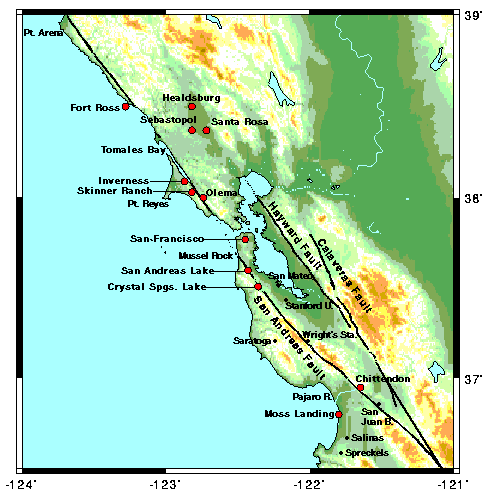
On April 18, 1906, shortly after 5:00 a.m., a great earthquake struck San Francisco and a long narrow band of towns, villages, and countryside to the north-northwest and south-southeast. Many buildings were wrecked; hundreds of people were killed; electric power lines and gas mains were broken. Fires broke out and burned wildly for days, utterly out of control because of severed water mains.
The ground had broken open for more than 270 miles along a great fault - the San Andreas rift. The country on the east side of the rift had moved southward relative to the country on the west side of the rift. The greatest displacement had been 21 feet about 30 miles northwest of San Francisco.
Nearly all the scientists in California began immediately to assemble observations on the results of the quake. Professor A.C. Lawson, chairman of the geology department at the University of California, took the first steps that led to Governor George C. Pardee's appointment, three days after the shock, of a State Earthquake Investigation Commission to unify the work of scientific investigations then under way. The members of this Commission were Professor Lawson, Chairman; J.C. Branner, professor of geology at Stanford University; Charles Burckhalter, director of the Chabot Observatory at Oakland; W. W. Campbell, director of Lick Observatory; George Davidson, professor of astronomy at the University of California; G.K. Gilbert, geologist of the U.S. Geological Survey; A. O. Leuschner, professor of astronomy at the University of California; and H.F. Reid, professor of geology at Johns Hopkins University. With the exceptions of Gilbert and Reid, none of the Commission members were then known as students of earthquakes. Nevertheless, they were a distinguished and highly competent group of men. Two of the geologists and two of the astronomers were then members of the National Academy of Sciences and three others subsequently became members of that body.
At its first meeting three days after it was appointed, the Commission organized itself into two committees. One, chaired by Lawson, was to determine surface changes associated with the earthquake and to collect data on the intensity at different places. The second committee, with Leuschner as chairman, was assigned the collection of data on the time of arrival of the earthquake at different places. A few weeks later, when the main features of the quake had become known, a third committee, led by Reid, was appointed to consider problems of the geophysics of the earthquake. The three committees consisted of members of the Commission and 21 other scientists many of whom - such as Fusakichi Omori, professor of seismology at the Imperial University of Tokyo and on of the greatest seismologists of Japan - were already well-known and many others who later became internationally known as leaders in geology, mathematics, meteorology, and other fields of science.
No State funds were available to defray the expenses of the Commissions investigation, but provision for this purpose was made by the Carnegie Institution of Washington.
The Commission submitted a preliminary report of twenty pages to Governor Pardee on May 31, 1906. In November of the same year, the constitution of the Seismological Society of America was adopted. The first president of the Society was George Davidson, followed in successive years by A.C. Lawson, J.C. Branner, and A.G. McAdie, a member of Committee II of the Earthquake Commission. The secretary of the Society for many years was S.D. Townley, also a member of Committee II.
In preparation of the final report, hundreds of people were interviewed and evidence was collected from every damaged area as well as from records from seismograph stations throughout the world. Lawson spent the winter of 1906-1907 in Washington compiling and editing individual reports from more than twenty collaborating scientists. He prepared an introduction, a section on the geology of the Coast Ranges, and many explanatory statements and summaries to weld the work into one unified report. Volume I, parts I and II, and the accompanying folio atlas were published in 1908 by the Carnegie Institution of Washington. volume II, The Mechanics of the Earthquake, by H.F. Reid, followed in 1910.
The exhaustive report was favorably received on its publication and it continues even today to be very highly regarded by seismologists, geologists, and engineers concerned with earthquake damage to buildings. Volume I, established a model of earthquake investigation and reporting that has been widely followed ever since. Furthermore, it affords an invaluable pictorial record against which tectonic and other geologic changes since 1906 can be compared. Reid's masterly presentation of the elastic rebound theory of earthquakes in Volume II, remains today an apparently satisfactory explanation of one of the more important mechanisms of seismic activity. In all, the report stands as a milestone in the development of an understanding of earthquake mode of action and origin.
- William W. Rubey
Lawson, Andrew C., The California Earthquake of April 18, 1906. Report of the State Earthquake Investigation Commission, Carnegie Institution of Washington, 1908. Pub. no. 87, vol. I, pp. 451. Reprinted 1969.
Still available from the Carnegie Institution of Washington for $35.00 plus $4 postage (domestic orders). Orders can be paid by M/C or visa, and sent to Carnegie Institution, 1530 P St., NW, Washington, DC 20005. Telephone: 202-939-1121 and web site http://www.ciw.edu

Prepared by:
Last Changed September 3, 2004